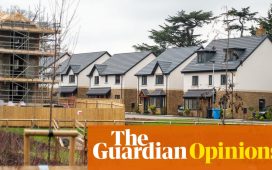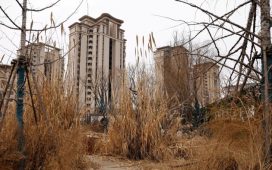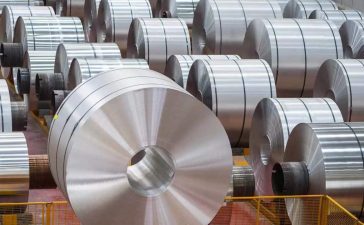China is moving away from its “three red lines” policy of limiting leverage in the property sector, after its effort to reduce risky lending and real estate speculation helped fuel a wave of defaults and triggered a slump in the property market.
Beijing is now easing constraints on developer credit and even rolling out potential loans following a severe downturn that saw housing and land sales collapse, threatening a major pillar of an economy already ailing from coronavirus lockdowns.
Officials at multiple state-owned banks said they had effectively shelved the leverage curbs — whose three red lines refer to targets for debt, equity and assets for individual companies — in their assessment of borrowers. Late last year, state-owned banks announced hundreds of billions of dollars of potential new lending to property developers.
“The three red lines are meaningless for now, and nobody talks about it anymore,” said Dong Ximiao, chief researcher of Shenzhen-based Merchants Union Consumer Finance.
“China’s policies are always focusing on seizing the moment,” he added. “Just as [the three red lines] can be put aside for now, it can be revived whenever needed to curb property prices.”
The backtrack may come too late for the likes of China Evergrande, whose default more than a year ago set in motion a liquidity crisis across the sector. Creditors are meeting this week with representatives of the company, which is not eligible for the state bank credit lines and whose international investors are trying to salvage their holdings through an opaque restructuring process.
Evergrande has missed a series of self-imposed deadlines to restructure its $300bn in liabilities, which made it the most indebted property developer in the world at the time of its official default in December 2021.
In recent months, authorities’ approach to China’s struggling property sector has changed dramatically as they seek to limit contagion and buoy flagging economic growth. Full-year gross domestic product data, set to be released on Monday, are expected to miss a 5.5 per cent target, which was the lowest in decades.
Beijing introduced the deleveraging policy in the summer of 2020. China had cut interest rates in the wake of a Covid-induced economic downturn, and property and stock prices boomed, leading policymakers to openly warn of a housing bubble.
Constraining leverage in the real estate sector, which through decades of mass urbanisation came to account for more than a quarter of overall economic activity, has been a longstanding ambition of Chinese policymakers.
President Xi Jinping famously declared in 2017 that houses were for “living in” rather than “speculating”, as a cycle of unchecked lending and construction drove house prices higher and threatened to put home ownership in major cities out of reach for many ordinary Chinese.
Beijing had originally set a target of summer 2023 for property market companies to comply with the three red lines. An FT analysis in 2021 found half of 30 major developers were in breach of the rules, which required them to hold cash equal to short-term borrowing, limited liabilities to 0.7x assets and required net debt to be equal or below equity.
The restrictions have yet to reshape many balance sheets. Andy Suen, a portfolio manager at PineBridge Investments, notes that of the 28 property developers he monitors, 16 complied with the three red lines in 2021, and only 13 did in mid-2022.
“It’s likely that many developers couldn’t meet this target anyway by mid-2023 because sales have been slowing down so much that they couldn’t really deleverage,” he said, adding this would make it “tricky” for lenders to decide whether to offer new loans.
The depth of the crisis across the sector is severe. Data from property research group CRIC, published in domestic media, show sales at the 100 biggest developers fell more than 40 per cent in 2022. This, combined with a shutdown on lending from banks and investor flight from the corporate bond market, has in turn limited developers’ ability to raise funds or cover their existing liabilities.
While the three red lines policy was meant to shore up balance sheets, the real estate sector remains “fundamentally insolvent”, said Brock Silvers, chief investment officer at private equity firm Kaiyuan Capital in Hong Kong, adding that excessive debt levels “continue to threaten China’s economic vitality and stability”.
An official at one of China’s biggest state banks said regulators were promoting mergers and acquisitions as a possible solution for troubled developers. They have also increased credit lines: in late November, Chinese state-owned banks unveiled $256bn of potential lending targeted towards “high-quality” developers. But the official added that banks were still “cautious” about lending and M&A activity had not materialised.
S&P, the rating agency, said in a report this week that it “does not believe the recent policies [state bank lending] aim to bail out creditors”, but instead to “set a floor for the downward spiral for the sector”. Analyst Esther Liu cautioned that the rescue package will “add new debts and increase the debt burden”.
Suen at PineBridge Investments pointed out that while the wave of defaults was probably an “unintended consequence” of the deleveraging push, the policy may have achieved its goal of reducing the economy’s reliance on the property market.
“We’re talking about a market that is 40 per cent smaller in terms of sales,” he said. “This sector probably won’t be a growth driver going forward, which arguably is also one of the policy objectives.”
Additional reporting by Andy Lin in Hong Kong











